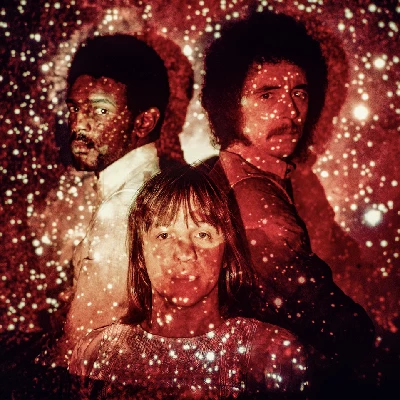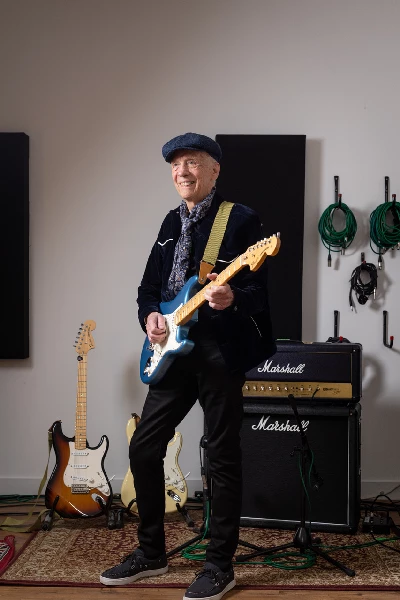published: 19 /
12 /
2024

When British guitarist/songwriter Robin Trower tours the UK and the US in 2024, he will feature songs from his 1974 gold record, ‘Bridge of Sighs,’ which is being meticulously reissued in May. Lisa Torem talks to him about the tour and the reissue.
Article
Robin Trower justifiably earned the title of rock royal as a member of Procol Harum from 1967-1971, but ever since the British guitarist/songwriter has forged full speed ahead in his solo career as a dynamic bandleader of a power trio. His gold records notwithstanding, this prolific polystylist has released a stunning discography which includes soul-fulfilling compilations and thought-provoking live and studio recordings. He is also known for creatively collaborating behind the glass with the likes of Jack Bruce and Bryan Ferry.
With Robin’s 2nd studio album,1974’s solid gold ‘Bridge of Sighs’ being reissued on May 17th and both an ambitious US. and UK. tour taking place this year, this one-off artist has a lot of news to share. Lisa Torem is thrilled to catch up with Robin Trower for his second pennyblackmusic interview, as they discuss songwriting, touring and studio practices then and now.
PB: Let’s backtrack for a minute. Who were your earliest musical influences?
RT: I always say the biggest musical influence, early on, was Scotty Moore, Elvis Presley’s guitar player because it was Scotty’s playing that made me want to play guitar. And then, the next biggest influence is BB King; that completely changed my idea of what lead work should be about.
Albert King was another huge influence and Jimi Hendrix, a big, big influence. I always say that BB King, Albert King and Jimi Hendrix were my three mentors.
PB: The 50th Anniversary of your second album, ‘Bridge of Sighs’ will be available in multiple formats, including Dolby ATMOS. But that project features other “firsts” for the fans, such as ‘Live at The Record Plant, Sausalito, 29th May 1974’, plus outtakes and rarities. Please elaborate on the project highlights.
RT: I remember doing the Record Plant and the audience being there. It was quite unusual to be in a recording studio and to have an audience. I think it turned out alright and it stands out quite well, considering how long ago it was.
PB: Do you follow a formula for songwriting? How does it generally evolve?
RT: I like to pick up the guitar every day, usually in the morning. Every song starts off with a guitar idea. I have to think that there is a real character in the guitar part that I build a track from. Maybe at the same time, I’m developing the guitar idea. I’ll be thinking about the vocal; the top line, the melody, and then, I’ll nail that one and follow with the lyric.
Actually, the lyric is the thing that takes the most time. I’ll spend three, four, five days on a lyric just to get it dead right to the best of my ability.
PB: The booklet that accompanies the album includes interviews with you and producer Matthew Fischer, plus testimonials by Bryan Ferry, Robert Fripp, Steve Lukather, Clive Bunker, Andy Parker and cover designer Paul Olsen. These testimonials are not only by guitarists; the list includes drummers and front men, too. Did you ever anticipate influencing, not only guitarists, but musicians in general?
RT: No, I don’t think you do (Laughs). I don’t think you ever think, ‘Oh, am I going to influence anybody?’ It’s very gratifying when you hear from, especially, younger musicians that say they were influenced by you. It’s very, very gratifying.
PB: Have you been influenced by people that are not guitarists?
RT: Yes, by singers. Singers tend to be my very favourite musicians because the ones that I like are so soulful. I think it’s the soulfulness of the voice that you just can’t get from another instrument, really. People like Dinah Washington, Bobby Bland and James Browns. Howling Wolf I love, love, love. They are all big influences.
PB: Guitarist Steve Lukather commented specifically on your overall influence. “The tone, touch and feel was so incredible.” Fans and writers have also commented on your “tone” over the years. How did you acquire this tone?
RT: A lot of this has to do with experimentation overall. I don’t think I really got there right away. Obviously, it’s got a lot to do with the guitar I use. The strings; the amp. I hone it down to now. I just play a Signature Model Stratocaster which is made by Fairway and a Marshall Amp. and various overdrive pedals made by Ful-tone.
PB: How do you define the word, “tone?”
RT: A lot to do with it, to my ears, is why people like my sound, and it is because it is open. It is not linear. You can hear the impact of the plectrum on the strings. It has a semi-acoustic quality to it even though it’s very driven.
PB: It took two weeks for you and producer Matthew Fischer to record the original ‘Bridge of Sighs,’ with Geoff Emerick consulting on mic technique. What was Geoff’s impact on the project?
RT: Geoff Emerick was the engineer, so everything to do with the sound of that album had to do with him really. He invented a way of recording the guitar, which I don’t think had been done before, where he had three different microphones getting further and further away from my amplifiers and that’s how he captured the size of the sound. He just came up with that. He was a top, top engineer. A brilliant guy. Fantastic ears.
The recording was mostly done at Air London, which was George Martin’s studio. But a couple of tracks were done at Olympic Studios in Barnes.
PB: ‘Day of the Eagle’ is the opening track on Side A of the original record. ‘Little Bit of Sympathy’ was the closer on Side B. Can you explain the process of recording these tracks?
RT: ‘Day of the Eagle’—I have a feeling we were only playing that track live when we got into the studio. We’d done it on some of their shows. Obviously, by doing that, you’ve already got very confident about playing it, and I think, it comes over on that track. That was done in Air London.
‘Little Bit of Sympathy’ was one of the tracks that was done at Olympic, also, which was another very, top studio. What I like about ‘Little Bit of Sympathy’ is that all the lead work was done live. In other words, it just went down as a three piece and then vocals were added.
PB: This album was recorded way before musician began forwarding tracks to each other. How do you feel about that procedure, having experienced both ways of recording? Has anything been lost in that process?
RT: Well, it makes life a lot easier, especially during Covid. We were able to carry on making records. But I have to say, a lot of the music I hear today sounds a bit thin because you’re not really getting the interaction between players and instruments because it’s more layered now.
I must admit that is kind of what I do with the modern stuff that I do, but I’m still trying to emulate what will be a live performance. So, that’s the big difference; the way that I go about it.
PB: You will be performing four shows in May 2024 in the UK.- Will you draw primarily from ‘Bridge of Sighs’ or include other songs from your vast catalogue?
RT: I’m doing quite a cross section. There’s always stuff from ‘Bridge of Sighs.’ You’ve got to put that in. But I’m doing a few tracks that I’ve never played before, some songs off of ‘No More Worlds to Conquer,’ and a couple of songs that I’ve never played. I’m really looking forward to getting in some new material because it will be really fresh, plus I’ll be doing some songs from my next album, which is not out until next year. I want to play them, so I’m going to put them in.
I’ll be playing with the same line-up as on ‘No More Worlds to Conquer,’ which is Richard Watts on vocals and Chris Taggart on drums. It’s basically the same line-up that I’ve used for playing live for several years now.
PB: You will be embarking on a 29-city tour in September and October in the US, starting in Des Moines, Iowa and ending in Atlanta, Georgia, plus releasing a live concert DVD as well. What are you most looking forward to on the upcoming tours?
RT: Just getting in front of the US audiences because they give you such a boost. I think I’ll really come to life once I start playing live again, especially in the U.S.
PB: You recorded ‘Joyful Sky’ last year, featuring Brooklyn vocalist Sari Schorr. Tell us about your musical collaboration with Sari.
RT: At the time, last year, we were both managed by the same guy. And our manager asked me if I could write something for Sari. I hadn’t heard her up until that point, but he sent me a couple of tracks. I knew straight-away that we could do something great together because she’s got a dynamite voice. It started with me just writing a couple of things for her and from there it progressed into a whole album.
PB: The songs you have done together, such as, ‘Burn’ and ‘The Distance’ are packed with emotion.
RT: Thank you very much.
PB: Have you ever written songs while in a dream state?
RT: No, but I have to wake up in the middle of the night because I’ll have been thinking about the lyric. An idea will come and I’ll have to write it down. That proves that the brain is still working while you’re asleep.
PB: The acoustic trio, ‘Connolly Hayes’ (singer/songwriter Jess Hayes and guitarist Frankie Connolly) will be your warm-up act. Did you intentionally choose an acoustic act to contrast your large, electric sound?
RT: I like having a lighter sound in the opening act. It’s difficult if the audience has had a pounding until I come on because it can be very tiring if it is too heavy. So, I like that idea of an acoustic act. Yea, it’s great.
PB: Does the material of an act matter to you?
RT: No, I don’t think it particularly matters, as long as it’s musical. That’s the most important thing.
PB: How do you feel about touring now, as opposed to earlier in your career?
RT: I have to take it just a little bit easier than I used to. That’s the only thing. But I’m just as excited about playing live as ever.
PB: Do you have any advice for rising stars?
RT: The best thing is to be true to yourself. Make sure that what you’re doing is right and that you believe in it.
PB: Last question. Is there anything that you’d like to say to your fans?
RT: Tell them I’m looking forward to coming and playing high.
PB: Thank you.
The top two photos were taken by Brian Cooke and the lower photo by Sari Schorr.
Band Links:-
https://twitter.com/robintrower
http://www.trowerpower.com/
https://www.facebook.com/RobinTrower
http://robintrower.ning.com/
https://www.instagram.com/robintroweru
Play in YouTube:-
Have a Listen:-
Picture Gallery:-

